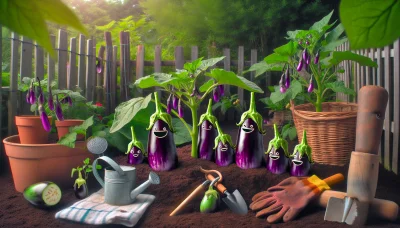Paw paw nutrition Quiz
Test Your Knowledge
Question of
The Nutritional Benefits of Paw Paw: A Gardener's Guide
Understanding the nutritional value of paw paws is essential for both gardeners and health-conscious individuals. This unique fruit, often overlooked, is a powerhouse of vitamins, minerals, and antioxidants that can significantly contribute to a balanced diet. For gardeners, growing paw paws not only enriches the biodiversity of their gardens but also provides a sustainable source of nutritious food. Health-conscious individuals can benefit from incorporating paw paw into their diets, taking advantage of its health-boosting properties. Embracing the paw paw is a step towards a healthier lifestyle and a more diverse garden ecosystem.
What is Paw Paw?
The Paw Paw, scientifically known as Asimina triloba, is a small deciduous tree native to the Eastern United States and Canada. What makes the Paw Paw truly unique in the gardening world is its large, tropical-like leaves, purple flowers, and its fruit, which is the largest edible fruit native to America. The Paw Paw fruit has a custard-like texture with a flavor that is often compared to bananas, mangoes, and melons. This tree is not only prized for its delicious fruit but also for its low maintenance and pest resistance, making it an attractive addition to both edible and ornamental gardens.
Cultivating Paw Paw Trees
Paw paw trees, known scientifically as Asimina triloba, are a unique addition to any garden, offering not just lush foliage but also delicious fruits. For successful cultivation, these trees require specific conditions that mimic their native woodland habitats. Firstly, soil quality is paramount; paw paw trees thrive in rich, well-drained, slightly acidic to neutral soil. Incorporating organic matter into the planting site can significantly enhance the soil's suitability. When it comes to climate, paw paw trees are best suited to temperate regions, being hardy in USDA zones 5 through 9. They can withstand brief periods of cold but are not suited to prolonged freezing temperatures. Sunlight exposure is another critical factor; while young trees benefit from partial shade, mature paw paw trees need full sunlight to produce fruit efficiently. However, too much direct sun in the seedling stage can be detrimental, so a balance must be struck to ensure healthy growth and fruitful harvests.
Paw Paw Nutritional Profile
- Vitamin C: Boosts the immune system and acts as an antioxidant.
- Vitamin A: Supports eye health and skin integrity.
- Magnesium: Important for muscle and nerve function, blood glucose control, and bone health.
- Potassium: Helps regulate blood pressure and is important for heart and kidney function.
- Iron: Essential for the production of red blood cells and transport of oxygen throughout the body.
- Antioxidants: Helps to neutralize harmful free radicals, potentially reducing the risk of chronic diseases.
- Dietary Fiber: Aids in digestion and helps maintain a healthy weight.
- Riboflavin (Vitamin B2): Important for growth, development, and the production of energy.
- Niacin (Vitamin B3): Supports the nervous system, digestive system, and skin health.
- Folate: Crucial for DNA synthesis and repair, and important during pregnancy for fetal development.
Harvesting and Storing Paw Paws
Paw paws, known for their creamy texture and tropical flavors, are best harvested when they are fully ripe, which is usually indicated by a slight softness to the touch and a more pronounced fragrance. It's crucial to handle them gently to avoid bruising. To preserve their nutritional value, avoid washing them until you're ready to consume or process them, as moisture can accelerate spoilage. For storage, paw paws can be kept at room temperature if they are to be eaten within a few days. For longer storage, place them in the refrigerator where they can last for up to a week. If you have an abundance of paw paws, consider pureeing the flesh and freezing it in airtight containers, which can extend their usability for several months while retaining most of their nutritional benefits.
Incorporating Paw Paws into Your Diet
Paw paws, also known as the American custard apple, offer a rich source of vitamins and minerals, making them a great addition to any diet. To enjoy their creamy, tropical flavor, consider blending paw paws into smoothies or yogurt for a nutritious breakfast boost. Their natural sweetness pairs well with the tang of citrus in salads, providing a refreshing and healthy option for lunch. For a unique dessert, try baking paw paw bread or muffins, which not only highlights the fruit's exotic taste but also adds a moist texture to baked goods. Remember, when preparing paw paws, the fruit should be ripe, which enhances its nutritional benefits and ensures the best flavor profile for your meals and snacks.
Paw Paw: Beyond Nutrition
The paw paw tree, while known for its nutritious fruits, offers a plethora of benefits that extend far beyond its dietary value. Ecologically, the paw paw plays a significant role in supporting biodiversity. Its presence in a garden or landscape attracts beneficial wildlife, serving as a host plant for the zebra swallowtail butterfly, whose larvae feed exclusively on young paw paw foliage. This relationship highlights the tree's contribution to maintaining healthy populations of native butterfly species. Moreover, the dense foliage and large, drooping leaves of the paw paw tree provide shelter and nesting opportunities for various bird species, enhancing avian diversity. In terms of garden ecosystem sustainability, incorporating paw paw trees can lead to a more resilient and self-sustaining environment. Their deep root systems help in soil stabilization and moisture retention, reducing erosion and improving water quality. Additionally, by including paw paws in a diverse planting scheme, gardeners can foster a balanced ecosystem that is less reliant on chemical inputs and more resistant to pests and diseases. Overall, the ecological impact of growing paw paws, combined with their attractiveness to wildlife and contribution to a diverse and sustainable garden ecosystem, underscores the value of this native tree beyond its delicious fruits.












